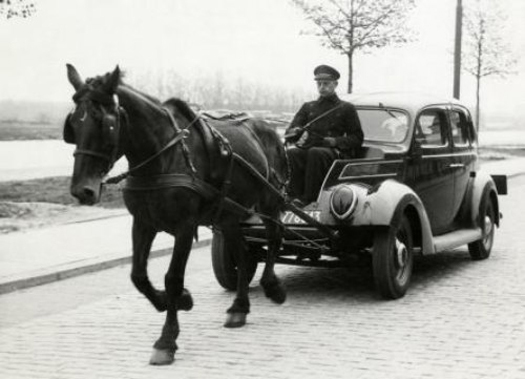
Gram junkies are those fanatical hikers and climbers who fret about every gram of weight that might be carried — in everything from titanium cook pans to toothbrush covers. Excess weight is not just an objective performance issue for these guys; they take it personally. In the matter of mobility and modern transportation, we all need to become gram junkies. We need to obsess not about speed, or about exotic power sources, but about the weight of every step taken, every vehicle used, every infrastructure investment contemplated.
Why? Because modern mobility not only damages the biosphere, our only home, but also global systems of air. Rail and road travel are also greedy in their use of space, matter, energy, biodiversity and land. Designers around the world are busily developing a dazzling array of solutions to deal with these complex challenges. The website Newmobility.org, for example, has identified 177 different projects and approaches to sustainable mobility. These include bus rapid transit (BRT), car free days, demand-responsive transport (DRT), hitch-hiking, pedestrianization, smart parking strategies and van-pooling.
The trouble is that every solution that assumes our current or increased levels of transport intensity, once whole system costs are calculated, turns out not to be viable. Many transport strategies help solve one or two problems — but exacerbate others. The best-known example is the way that the expansion of highways reduces congestion for a time, but tends to increase total vehicle traffic. Another rebound effect: increased vehicle fuel efficiency conserves energy; but, because it reduces vehicle operating costs, it tends to increase total vehicle travel. The growth of the US Interstate Highway System changed fundamental relationships between time, cost and space. These, in turn, enabled forms of economic development that have proved devastating to the biosphere.
Todd Litman, who runs the Victoria Transport Policy Institute in Canada, points out that depreciation, insurance, registration and residential parking are not directly affected by how much a vehicle is driven. Motorists maximize their vehicle travel to get their money’s worth from such expenditures and receive no incentives to drive less. Litman describes these market distortions as "economic traps" in which competition for resources creates conflicts between individual interests and the common good.
The effects of these economic traps are "cumulative and synergistic" in Litman's words: total impact is greater than the sum of individual effects and these distortions skew countless travel decisions and contribute to a long-term cycle of automobile dependency.
Modern mobility kills people too — but without fuss. The total number of people killed on 9/11 was 2,819. And yes, that was a tragedy. But consider this: An average of 3,242 people die worldwide on the roads each day of the year, year after year. Children are especially vulnerable; traffic accident deaths account for 41 percent of all child deaths by injury.
Even if it doesn't kill you outright, modern mobility contributes to poor health. The highest rates of obesity correlate 1:1 with the proportion of journeys children take by car — and the costs of obesity are heading for 10 percent of US GDP. Increased auto dependency and air pollution also contribute to respiratory illnesses, cardiovascular disease and hospital admissions.
We squander time on mobility. We spend the same amount of time traveling today as we did 50 years ago — but we use that time to travel longer distances. The average German citizen today drives 15,000 km (9,320 miles) a year; in 1950, she covered just 2,000 km (1,242 miles). A lot of our travel time is commuting time and work-related travel that we believe we cannot avoid. We also spend a lot of time traveling in order to shop and to take the kids to distant schools.
Even if modern mobility were not a climate change or social problem, the fact that global mobility depends on a finite energy source — oil — means it is fundamentally not resilient. Whether oil and gas are at a peak, or on a plateau, increasing consumption means that the 9 million gallons of gasoline people currently use in the U.S. each day simply will not be availabl in the future. Ninety-five percent of all transportation depends on oil — and with that, food systems in all developed countries are vulnerable to any disruption in the prevailing logistical system.
To a car company, replacing the chrome wing mirror on an SUV with one made of carbon fiber is a step toward sustainable transportation. To a radical ecologist, all motorized movement is unsustainable. So when is transportation sustainable, and when is it not?
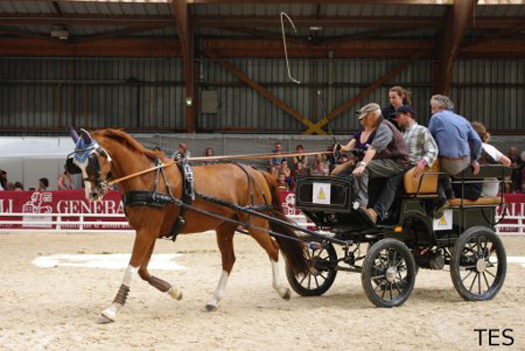
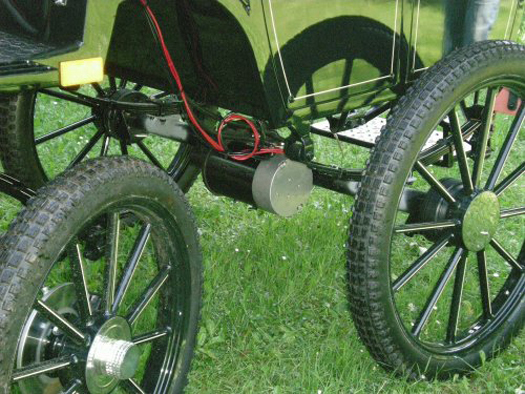
Motorized horse cart featured on the French website Traits en Savoie.
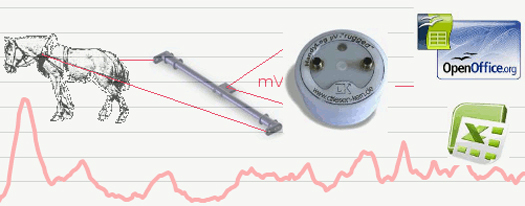
Meterus Horse Power, in France, is modernizing animal traction with an approach that combines technology, ecology, profitability and horse wellness. From Equishop website (Switzerland).
Chris Bradshaw, a transport economist, emphasizes that “light” transport systems are not, per se, sustainable — only less unsustainable than commuting by car. “Light rail supports far-flung suburbs; street cars support, well, street-car suburbs,” Bradshaw says. “A smaller, more efficient, or alternative-fuel vehicle is only less unsustainable than another private vehicle. It will still take up space on the road and in parking lots, it will still threaten the life and limb of others, it will still create noise, and it still will require lots of energy and resources to manufacture, transport to a dealer and dispose of when its life ends.”
Bradshaw wants planners and designers to respect what he calls “the scalar hierarchy.” This is when trips taken most frequently are short enough to be made by walking (even if pulling a small cart), while the next more frequent trips require a bike or street car and so on. “If one adheres to this, then there are so few trips to be made by car, that owning one is foolish.”
Investments in high-speed trains such as they are, is another non-solution. Europeans believe that high-speed trains are environmentally far friendlier than aircraft — but they're not. When researchers at Martin Luther University studied the construction, use and disposal of the high-speed rail infrastructure in Germany, they found that 48 kilograms (about a hundred pounds) of solid primary resources is needed for one passenger to travel 100 kilometers.
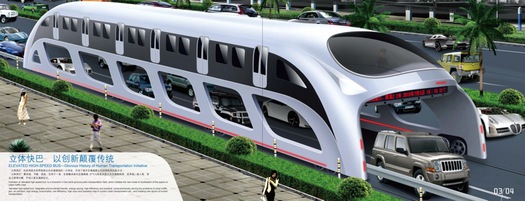
China's proposed "straddling" bus would use existing infrastructure to greatly increase capacity along arterial routes.
Is one answer to go by banana boat? Not really. The world's merchant fleet contributes nearly 4.5 percent of all global emissions — a huge amount, up there with cars, housing, agriculture and industry. (Like aviation, shipping emissions are omitted from European targets for cutting global warming.)
Electric cars are the biggest distraction of all. The assumption in European and U.S. policy is that renewable energy-powered smart grids will power millions of electric or hybrid vehicles. Unfortunately, these technology-driven solutions are not viable once the economics of electrical grid modernization are factored in. The German branch of the World Wildlife Foundation (WWF) published a study in May 2009 (conducted with IZES, a German institute for future energy systems). Electric cars only reduce greenhouse gases marginally, they found. The manufacturing processes of both the hybrid and the fully electric car require more energy than those of any conventional petrol-powered car. A worst-case (and frankly most likely) scenario is that most electric cars will be run on electricity from coal instead of from renewable sources.
The least talked about obstacle to electric transportation concerns the raw materials needed to manufacture the vehicles. Rare earth metals are key to global efforts to switch to cleaner energy and therefore transportation. But mining and processing the metals causes immense environmental damage. China’s rare earth industry each year produces more than five times the amount of waste gas, including deadly fluorine and sulfur dioxide, than the total flared annually by all miners and oil refiners in the U.S. Alongside that 13 billion cubic meters of gas is 25 million tons of wastewater laced with cancer-causing heavy metals such as cadmium. And, just as we already have a problem with peak oil, a shortfall looks likely in the world’s capacity to produce lithium. One rare metals expert, William Tahil, claims the production of hybrid and electric cars will soon tax the world’s production of lithium carbonate.
Think More, Move Less
Politicians tend to dissemble or lie, or both, whenever the subject of transportation strategy crops up. Despite proof that transportation damages the biosphere, costs a fortune and kills people, the policy establishment is in thrall to the belief that transportation-enabled economic growth takes priority over all else. This false belief is based on inadequate ecological accounting, and the power of the myriad industries involved. Every aspect of the aviation industry, for example — airplane manufacturers, airlines, airports — is subsidized by direct grants and tax breaks. Remove these hidden subsidies and also charge aviation the true costs of its environmental impact and the whole enterprise becomes un-economic even on its own terms.
Politicians are also scared that no voter will tolerate a curtailment of air travel. The better way to put it is that no rich voter will do so. Only 5 percent of the world’s population has ever flown. Aviation is overwhelmingly an activity of the rich, and strong measures to combat the environmental impact of aviation would not adversely effect poor people.
We once hoped that the internet would replace trips to the mall; that air travel would give way to teleconferencing; and that digital transmission would replace the physical delivery of books and videos. In the event, technology has indeed enabled some of these new kinds of mobility — but in addition to, not as replacements for, the old kinds. The internet has increased transport intensity in the economy as a whole. Rhetoric of a “weightless” economy, the “death of distance” and the “displacement of “matter by mind” sound ridiculous in retrospect.
Rather than tinker with symptoms — such as inventing hydrogen-powered vehicles, or turning gas stations into battery stations — the more interesting and pertinent design task is to re-think the way we use time and space and to reduce the movement of matter — whether goods or people — by changing the word "faster" to "closer."
Our transportation challenge can be compared to distributed computing. The speed-obsessed computer world, in which network designers rail against delays measured in milliseconds, is years ahead of the rest of us in rethinking space-time issues. It can teach us how to rethink relationships between place and time in the real world, too. Embedded on microchips, computer operations entail careful accounting for the speed of light. The problem geeks struggle constantly with is called latency — the delay caused by the time it takes for a remote request to be serviced, or for a message to travel between two processing nodes. Another key word, attenuation, describes the loss of transmitted signal strength as a result of interference — a weakening of the signal as it travels farther from its source — much as the taste of strawberries grown in Spain weakens as they are trucked to faraway places. The brick walls of latency and attenuation prompt computer designers to talk of a “light-speed crisis” in microprocessor design. The clever design solution to the light-speed crisis is to move processors closer to the data — in ecological terms, to re-localize the economy.
Network designers are good localizers. Striving to reduce geodesic distance, they have developed the so-called store-width paradigm or “cache and carry.” They focus on copying, replicating and storing web pages as close as possible to their final destination, at content access points. Thus, if you go online to retrieve a large software update from an online file library, you are often given a choice of countries from which to download it. This technique is called “load balancing” — even though the loads in question, packets of information, don’t actually weigh anything in real-world terms. Cache-and-carry companies maintain tens of thousand of such caches around the world.
By monitoring demand for each item downloaded and making more copies available in its caches when demand rises and fewer when demand falls, operators help to smooth out huge fluctuations in traffic. Other companies combine the cache-and-carry approach with smart file sharing, or "portable shared memory parallel programming." Users’ own computers, anywhere on the internet, are used as shared memory systems so that recently accessed content can be delivered quickly when needed to other users nearby on the network.
The Law of Locality
My favorite example of decentralized production concerns drinks. The weight of beer and other beverages, especially mineral water, trucked from one rich nation to another is a large component of the freight flood that threatens to overwhelm us. But first Coca-Cola and now a boom in microbreweries demonstrate a radically lighter approach: Export the recipe and sometimes the production equipment, but source raw material and distribute locally.
People and information want to be closer. When planning where to put capacity, network designers are guided by the law of locality; this law states that network traffic is at least 80 percent local, 95 percent continental and only 5 percent intercontinental. Communication network designers use another rule that we can learn from in the analogue world: “The less the space, the more the room.” In silicon, the trade-off between speed and heat generated improves dramatically as size diminishes: Small transistors run faster, cooler and cheaper. Hence the development of the so-called processor-in-memory (PIM) — an integrated circuit that contains both memory and logic on the same chip.
So, too, in the analogue world: radically decentralized architectures of production and distribution can radically reduce the material costs of production. We need to build systems that take advantage of the power of networks — but that do so in ways that optimize local-ness.
This design principle — “the less the space, the more the room” — is nowhere better demonstrated than in the human brain. The brain, in Edward O. Wilson's words, is “like one hundred billion squids linked together... an intricately-wired system of nerve cells, each a few millionths of a meter wide, that are connected to other nerve cells by hundreds of thousands of endings. Information transfer in brains is improved when neuron circuits, filling specialized functions, are placed together in clusters.”
Neurobiologists have discovered an extraordinary array of such functions: sensory relay stations, integrative centers, memory modules, emotional control centers, among others. The ideal brain case is spherical or close to it, Wilson observes, because a sphere has the smallest surface relative to volume of any geometric form. A sphere also allows more circuits to be placed close together; the average length of circuits can thus be minimized, which raises the speed of transmission while lowering the energy cost for their construction and maintenance.
Like gram junkies, the mobility dilemma is not as hard to solve as it looks once one replaces the word “speed” with the word “weight.” By changing the success measurement from faster to closer, it becomes possible to borrow from other domains, such as microprocessor design, network topography and the geodesy of the human brain. The biosphere itself is the result of 3.8 billion years of iterative, trial-and-error design — so we can safely assume it’s an optimized solution. As Janine Benyus explains in her wonderful book Biomimicry: Innovation Inspired by Nature, biological communities, by and large, are localized or relatively closely connected in time and space. Their energy flux is low, distances covered are proximate. With the exception of a few high-flying species, in other words, “nature does not commute to work.”

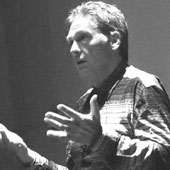
Comments [7]
01.26.11
08:02
01.26.11
10:33
01.29.11
01:26
Speaking of the beer and mobility: you should check out the book Brew to Bikes by Charles Heying that describes how the Artisan Economy is transforming Portland.
Chris
02.03.11
03:43
10.23.11
04:07
Your comments on high-speed rail are quite pertinent here in Australia. We have very busy air corridors between the cities of our eastern states and high-speed rail is being pushed as a "solution".
While agreeing on your basic contentions about electric and hybrid cars, it is worth mentioning that several Toyota Priuses and possibly some Camry hybrids are in use as taxis in Melbourne, Australia. It would seem to be a more appropriate use for the technology (and embodied resources) than in lower-mileage private cars. However I have no data on how well the taxis are going as far as maintenance, battery life and so forth.
11.29.11
06:52
02.08.12
12:23